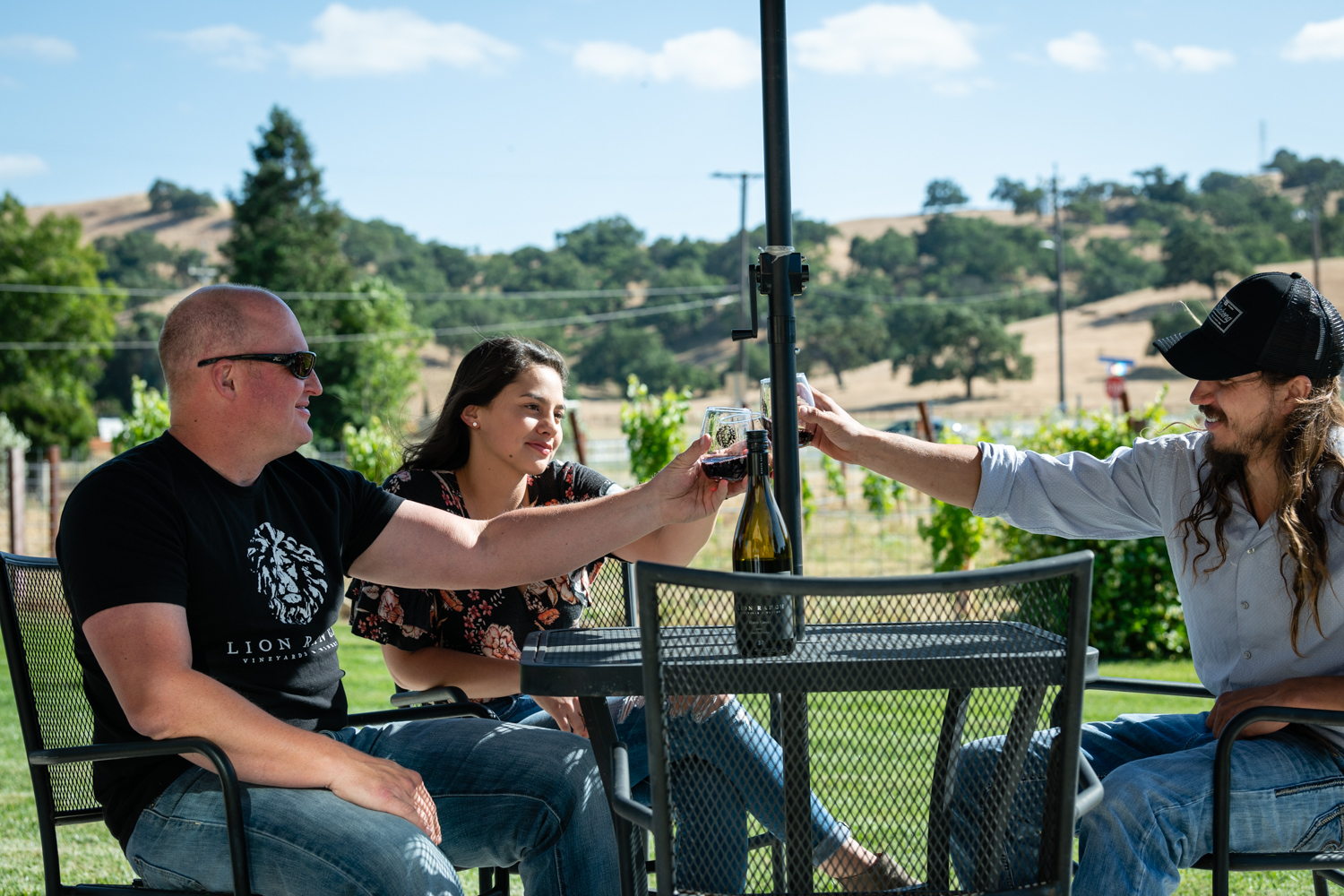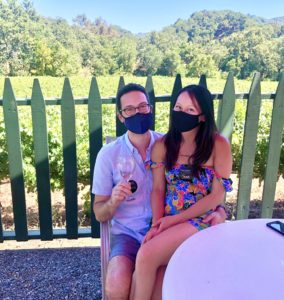Wineries began re-opening in mid-July following county safety protocols

Photo courtesy Lion Ranch Winery
Co-owner and co-winemaker Todd Engelhardt enjoys a bottle with Kristy Lau, and Ben Nuno at Lion Ranch.
By Marty Cheek
The virus stopped the flow of vino — at least temporarily. In mid-July, South Valley wineries started re-opening their sites by following protocols from the Santa Clara County Public Health Department to ensure customers are safe from possible COVID-19 contamination.
Among the changes customers will see is tasting service is limited to outdoor areas only. Customers must wear face coverings while not sipping wine, waiting in line, going to or from their table, or touring winery grounds; Tastings may occur by appointment only and are restricted to groups of up to six.
The Wineries of Santa Clara Valley, an association of 35 wineries in the county, worked with the nonprofit Wine Institute’s lawyers to sift through the protocols that set them apart from restaurants, bars and breweries in order to open again, said Gena Guglielmo, vice president on the board.
“Now that we are able to have outdoor tastings without the food aspect, it allows us to create a much safer environment for the business that we’re in, which is giving people the opportunity to sit outside and enjoy good wine,” she said.

Photo courtesy Margie Hinman at Martin Ranch Winery
Ventz and Jenn Pavlov from Mountain View enjoy some time together at Martin Ranch Winery during the COVID-19 pandemic.
The wineries have long been known for being friendly to guests. The social-distancing will limit some of that social interaction, unfortunately, to manage the flow of customers to help prevent the spread of the virus. Hand-held menus are being replaced by a posted chalkboard or other signage. Wine is pre-poured before customers arrive, and ordering and paying from a phone are other measures local wineries are implementing.
“Anytime you come into a tasting room, you’re bumping elbows with the owners, the family, the winemakers,” Guglielmo said. “That sense of community has been stripped away from not only our staff and our family but our community.”
Wineries such as Guglielmo have plenty of patio space to relax. Customers may bring a picnic to nibble on as they enjoy the vino. Some wineries such as Fortino and Clos LaChance have restaurant licenses thus they can prepare food on site. Others are partnering with local restaurants to serve pre-ordered meals — such as Verde Vineyard serving cuisine from The Milias Restaurant in downtown Gilroy.
Guglielmo Winery decided it didn’t want to offer meals because that’s an extra touch point, Guglielmo said.
“We know how to safely do what we’re doing here — make great wine — because we know the business,” she said. “We do sell nibbles in bags if they want to eat.”
When guests come on property, they have to wear a mask, and they can’t take it off until they start consuming wine, Guglielmo said.
“We didn’t know at first if we were going to get any push-back on that stuff,” she said. “But to be honest, I feel a lot more confident now. People have been so gracious, so cooperative. I haven’t got any push-back.”
Several wineries offered events throughout the year such as summer concerts and family-friendly festivals. The COVID-19 protocols ordered by the county prevent these entertainment gatherings. One of the biggest events Guglielmo Winery puts on during the holiday season is its annual Christmas Fair where people come into the tasting room store to shop for unique gifts. It can draw up to 500 people a day. More than likely if the coronavirus crisis continues through the rest of the year, that event will be cancelled.
 Weddings during the spring and summer months play an important part of many local wineries’ business models. Now that these are restricted to small gatherings, it has been a hard hit on their revenue stream.
Weddings during the spring and summer months play an important part of many local wineries’ business models. Now that these are restricted to small gatherings, it has been a hard hit on their revenue stream.
“I think one the most painful things I have to do is call a couple up and tell then they have their wedding (here),” Guglielmo said.
Many South Valley wineries are finding creative ways to stay open. Being flexible and going with the flow with innovative ways to get around the business obstacles is vital in this situation if the wineries are going to survive. Many are doing curbside sales where customers pay in advance online and call staff to bring out their order when they arrive.
Free deliveries to people’s homes within the Santa Clara Valley region is another way to keep up the sales. Guglielmo has a policy of a six bottle minimum for free delivery. Gena and her sister, Angelia, enjoy loading up the company van and making home deliveries. They call the customer ahead of time. Then after the drop-off on the doorstep, they call again to ask them to come out to get their purchase. The Alcohol Beverage Control department waived the signature requirement, but they need to make a visual confirmation that an adult made the purchase.
 “You’re literally the milkman of wine,” Guglielmo said with a laugh.
“You’re literally the milkman of wine,” Guglielmo said with a laugh.
Despite the flexibility, many of the wineries are concerned about their business sustainability. As the crisis unfolded, the conversation changed.
“It’s now not how long can we sit tight but how do we safely open up our business and get really creative to make sure we come through this thing,” Guglielmo said.
The survival of the local wineries will require community members to continue supporting these businesses now that Santa Clara County has allowed them to invite guests back under public safety protocols. That support will come from the trust customers have in making sure their health is the top priority during a visit.
Another priority is to give people some time away from their shelter-in-place environment to enjoy themselves with friends and family.
“We’re trying to keep a very contained environment that gives people an opportunity, when they do sit at the table and have a glass of wine, when they listen to Italian music and look out at the vineyard, all this stuff melts away,” Guglielmo said.






